The Actual Trip (Part 3)
Charles Dowdell---Aug 8, 2003 |
|
Day 4Today was the first of our power plant tours. This area has three power plants, LG-1, LG-2 and LG-2A. Further up the La Grande River system there are several other power plants. They are hundreds of kilometers away on a gravel road known as the Trans-Taiga Highway. We were instructed not to attempt the Trans-Taiga highway since it was impassable at the time. I had arranged an English speaking tour months in advance. The plan was to tour LG-2 on one day and LG-1 the next which is about an hour drive away. I have always enjoyed tours of power plants especially hydro-plants since I was a kid. I also enjoy antique water mills here in upstate NY. Harnessing the power that is held in a river seems interesting to me. A few years back I coordinated a hard-hat tour of the Moses plant at Niagara falls. That tour is really a "must do" if you have not. Everyone is impressed, nerds and non-nerds alike. Raddison is a town that was established for building of the hydro-plants. Today there are few residents and they are generally transients that work for Hydro-Quebec. LG-2 being only one of the remote places to work before moving on to the next remote area. The town consists of modular housing except for the main dorm-hotel-administration complex. Electricity is free here. |
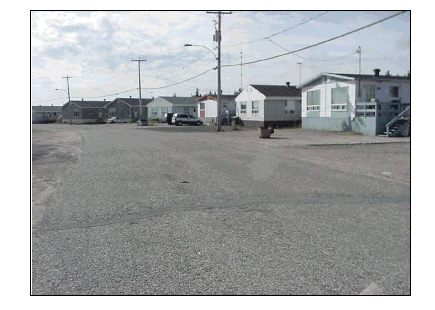
|
LG-2Photographs are not allowed inside the power plants like they were in the past. I will have to describe much of what I saw. Movie of the LG-2 Animation Display The animation shows the cut-out of granite that LG-2 is built in. The turbines and dynamos are almost 500 feet below the surface of the earth. It was a huge cut away into granite to build the whole thing. In the animation you can see the turbines and then after it a "surge chamber". The surge chamber functions like a huge burp and vent chamber before sending the river through the tail race and eventually out to the river again. I wish I could have brought my camera in. I think there were 16 turbines in LG-2. The powerhouse is 483 meters long and the head is 137 meters. That is by far the highest pressure hydro plant I have visited as well as the largest. This one power plant creates 5328 Megawatts of electricity. Or as I like to say, 5.3 Gigawatts of Hair-dryer frenzy. This is just one on the three power plants in the immediate area. This is a big power plant, I realize. |
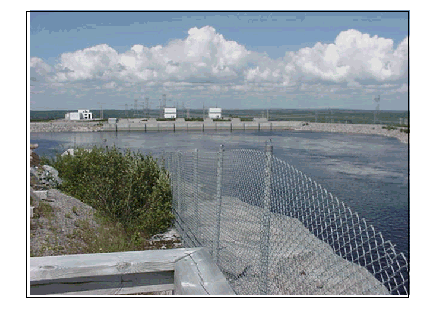
|
Inside the BeastThere are a couple of other folks from California with us for the tour. Their jaws are gapped just as ours when we get into the power house and can feel and hear the entire granite mountain tremble. The size is absolutely gargantuan. We went below in the power house to an operating turbine housing of about 12 feet in diameter (the tube, not the turbine diameter) and felt the turbulence not only in our ears and vibrations through our feet, but through the 6-inch thick steel housings. Next we go into the coupling area of the turbine and the dynamo. This is the pinnacle of any hydro plant tour. Keep in mind that the power plant is operating and we are talking hot, windy and very noisy during this experience. So windy that there is a special door used to equalize the pressure to open it. Unlike the tour at the Moses plant at Niagara, the shaft is enormous, much faster and there is a lot less oil flying around the room. The shaft used here is 3 meters across and spins at 130 RPMs! The dynamo which is open-view from within (over your head) weighs 620 tons and is about 60 feet in diameter. We climb inside all this within just a couple inches of reaching and touching all this huge fast-moving equipment. I think the guide said that each turbine here is 450,000 horsepower. |
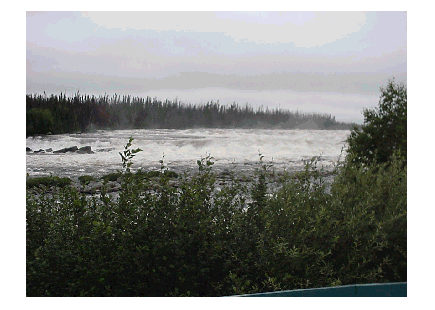
|
The Surge ChamberWe also got to visit the surge chamber!. As I indicated the power plant is 483 meters long. The chamber must be 75 meters high (half under water) and maybe 50 meters wide. There is a catwalk along the roof of the surge chamber that we were allowed to tour. The guide phoned the plant operator to ask permission before we could proceed, but the operator did indeed give us permission and up the stairs we went. I think is was about 13 flights of stairs all on that open metal grate type stair structures. Through the heavy steel double air lock bulkheads, like on a ship, and out onto an open steel mesh cat walk about a hundred fifty feet above the violently churning water below. Waves of turbulence came to the surface and then 10 seconds later more churning, almost like waves. It was windy, cold and very wet. The lighting is very dim especially compared to the power house. It looks like what you might imagine hell would be like. It is not a place for a human being. You cannot help but think what would happen if you fell over the modest handrail system or the catwalk broke. It would be a terrible and absolutely certain end. I suspect in 15 minutes they would find your body at the outlet, if it still floated. |
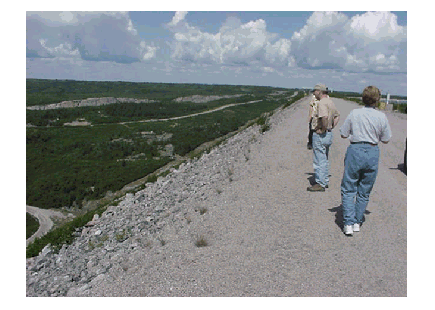
|
The ReservoirThe outside portion of the tour was important for the overall context of the power plant system. The size of the power plant system is huge and it is easy to loose the associations of dams, reservoirs and power houses without a comprehensive tour. The dams to build the huge reservoirs are approximately 50 stories high. I realized that when we were driving on the dam, there were no guard rails and there was nothing to stop us from falling over the edge of the dam 50 stories down. It is hard to visualize the amount of land that was flooded by these dams. LG-2 and LG-2A power plants run off the main reservoir. LG-2A was added after more water was diverted from the Eastmain river into the La Grande river system. |
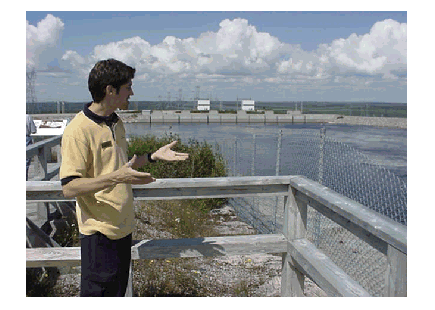
|
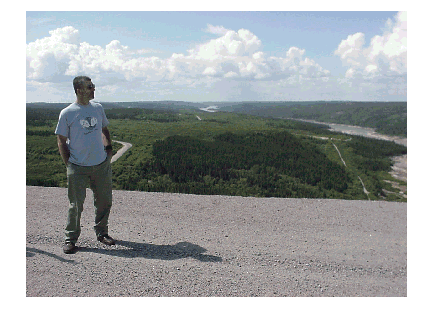
Jeff on dam over looking the downstream section of the Le Grande River |
|
|
The LG-2 and LG-2A power and their associated reservoirs have little concrete work. The geology is such that the granite and other local materials worked well to form a strong, watertight dam. The water inlets are all below the surface so the frozen water above has no impact on flow. |
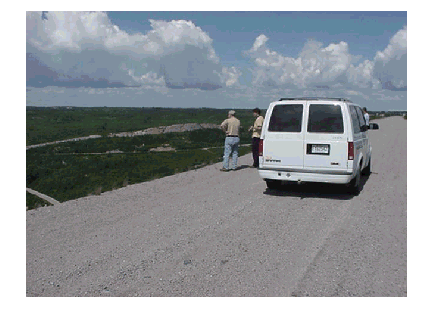
|
The Giant StaircaseOne of the more well known features of the Le Grande complex and LG-2 is the overflow channel. Although it has only been opened once and may never be used again, an effective overflow control system is important for the overall hydro management system. To help you scale the granite cutout, each one of those steps is approximately 50 feet high. It is truly a giant's staircase. |
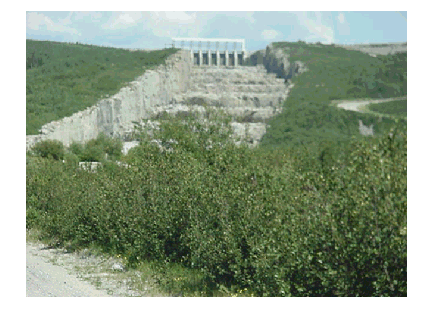
|
|
At the base of the dam we found the now obsolete diversion tunnel used in the construction of the dam. We also saw some snow that had not yet melted on August 1st. Additionally, in this area we saw some caribou skeletons. It turns out that a herd of caribou ended up down this way a year or so ago around Christmas time. These herds can get huge in this part of the world. This herd however, was only about 10,000 head. |
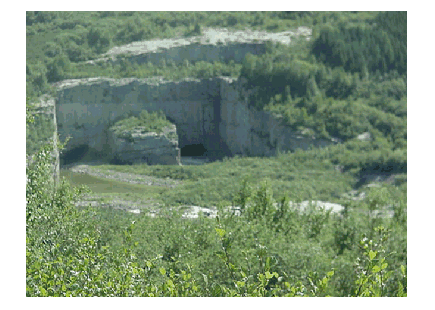
|
|
|
|
Continue to Part 4- The Actual Trip |
|
|
|